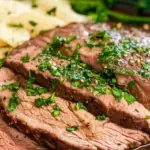The Perfect Bottom Round Roast: A Step-by-Step Guide to a Succulent Meal
When it comes to preparing a delicious and hearty meal for family and friends, few things compare to the succulent goodness of a perfectly cooked roast. The Bottom Round Roast, a cut of beef from the round section of the cow, stands out as an excellent choice for a flavorful yet affordable meal. With its lean texture, this roast can be transformed into a tender, juicy masterpiece when prepared with the right techniques.
- Prep Time: 10 minutes
- Cook Time: 1 hour 45 minutes
- Total Time: 1 hour 55 minutes
- Yield: 8 servings 1x
- Category: Main Course, Beef
- Method: Roasting, Slow Cooking
- Cuisine: American
- Diet: Gluten Free
Ingredients
For the Roast:
- 3–4 pound bottom round roast (adjust based on the number of servings you need)
- 4 tablespoons olive oil, divided
- 1 tablespoon kosher salt
- 2 teaspoons black pepper
- 1 teaspoon onion powder
- 1 teaspoon dried parsley
- 1 teaspoon dried thyme leaves
- 1 teaspoon dried rosemary
- ½ teaspoon garlic powder
- Fresh parsley for garnish (optional)
For the Gravy:
- 2 tablespoons sweet rice flour
- 2 cups low-sodium beef stock or broth
- 1 tablespoon Worcestershire sauce
- Salt and pepper to taste
Instructions
1. Preheat Your Oven
The first step is to preheat your oven to 450°F (232°C). The high initial temperature is key to developing a beautifully brown and crispy exterior on the roast. This initial sear locks in the juices and helps to form a flavorful crust.
2. Prepare the Skillet
While the oven is preheating, prepare your skillet by pouring 1 tablespoon of olive oil into the bottom of a cast-iron skillet or another oven-safe pan. Swirl the oil to coat the surface evenly. The skillet will help to evenly distribute heat and create an even roasting environment for the bottom round roast.
3. Season the Roast
In a small bowl, combine the remaining olive oil, kosher salt, black pepper, onion powder, dried parsley, thyme, rosemary, and garlic powder. Mix everything well to form a paste-like seasoning blend. Use your hands to rub the seasoning mixture all over the roast, making sure it’s covered completely. Don’t be afraid to massage the seasoning into the meat; the more thoroughly it’s coated, the more flavorful your roast will be.
4. Roast the Bottom Round
Once the roast is seasoned, place it in the prepared skillet and insert the skillet into the preheated oven. Roast at 450°F for 15 minutes. This will help create that beautiful crust on the outside of the meat. After the 15-minute mark, reduce the oven temperature to 325°F (163°C) and continue roasting for 1 to 1 ½ hours. The cooking time may vary slightly depending on the size of your roast and your desired level of doneness. For medium-rare, aim for an internal temperature of 125-130°F (52-54°C).
Use a meat thermometer to monitor the internal temperature. Roasting the meat at a lower temperature after the initial sear ensures that the roast cooks evenly and remains tender and juicy.
5. Let the Roast Rest
Once the roast has reached your desired internal temperature, remove it from the oven. Let it rest on a cutting board for at least 15 minutes. Resting is an important step in the cooking process because it allows the juices to redistribute throughout the meat. If you slice the roast immediately, you risk losing all those delicious juices, making the meat dry and tough.
6. Make the Gravy
While the roast is resting, it’s time to make the gravy. Place the skillet with the beef drippings over medium heat. The drippings are packed with flavor, so you’ll want to use every drop to make a rich, savory gravy. Sprinkle 2 tablespoons of sweet rice flour into the skillet and whisk constantly to form a paste. The flour will help thicken the gravy and give it a smooth, velvety texture.
Once the paste has formed, gradually add the beef stock while continuing to whisk to ensure the gravy remains smooth. Allow the gravy to simmer for 5-10 minutes until it thickens. Stir in the Worcestershire sauce for extra depth of flavor. Taste the gravy and adjust the seasoning with salt and pepper as needed.
7. Slice and Serve
After the roast has rested, slice it thinly against the grain. Slicing against the grain ensures that the roast is tender and easy to chew. Arrange the slices on a serving platter and drizzle with the homemade gravy. Garnish with fresh parsley if desired for a pop of color and added freshness. Serve immediately with your favorite sides, such as mashed potatoes, roasted vegetables, or a crisp salad.
Notes
- Resting Time is Key: As mentioned earlier, letting the roast rest before slicing is essential. This step prevents the juices from running out when you cut into the meat, ensuring that each slice is tender and juicy.
- Use a Meat Thermometer: A meat thermometer is your best friend when cooking a roast. It takes the guesswork out of determining whether the roast is cooked to perfection. For medium-rare, aim for an internal temperature of 125-130°F (52-54°C). If you prefer your roast more well-done, increase the temperature accordingly.
- Leftovers: Leftover roast can be used in sandwiches, wraps, or salads the next day. It’s perfect for making beef-based soups or stews as well.
